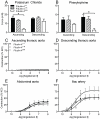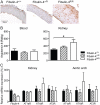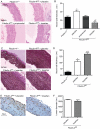Impaired vascular contractility and aortic wall degeneration in fibulin-4 deficient mice: effect of angiotensin II type 1 (AT1) receptor blockade
- PMID: 21858106
- PMCID: PMC3153486
- DOI: 10.1371/journal.pone.0023411
Impaired vascular contractility and aortic wall degeneration in fibulin-4 deficient mice: effect of angiotensin II type 1 (AT1) receptor blockade
Abstract
Medial degeneration is a key feature of aneurysm disease and aortic dissection. In a murine aneurysm model we investigated the structural and functional characteristics of aortic wall degeneration in adult fibulin-4 deficient mice and the potential therapeutic role of the angiotensin (Ang) II type 1 (AT(1)) receptor antagonist losartan in preventing aortic media degeneration. Adult mice with 2-fold (heterozygous Fibulin-4(+/R)) and 4-fold (homozygous Fibulin-4(R/R)) reduced expression of fibulin-4 displayed the histological features of cystic media degeneration as found in patients with aneurysm or dissection, including elastin fiber fragmentation, loss of smooth muscle cells, and deposition of ground substance in the extracellular matrix of the aortic media. The aortic contractile capacity, determined by isometric force measurements, was diminished, and was associated with dysregulation of contractile genes as shown by aortic transcriptome analysis. These structural and functional alterations were accompanied by upregulation of TGF-β signaling in aortas from fibulin-4 deficient mice, as identified by genome-scaled network analysis as well as by immunohistochemical staining for phosphorylated Smad2, an intracellular mediator of TGF-β. Tissue levels of Ang II, a regulator of TGF-β signaling, were increased. Prenatal treatment with the AT(1) receptor antagonist losartan, which blunts TGF-β signaling, prevented elastic fiber fragmentation in the aortic media of newborn Fibulin-4(R/R) mice. Postnatal losartan treatment reduced haemodynamic stress and improved lifespan of homozygous knockdown fibulin-4 animals, but did not affect aortic vessel wall structure. In conclusion, the AT(1) receptor blocker losartan can prevent aortic media degeneration in a non-Marfan syndrome aneurysm mouse model. In established aortic aneurysms, losartan does not affect aortic architecture, but does improve survival. These findings may extend the potential therapeutic application of inhibitors of the renin-angiotensin system to the preventive treatment of aneurysm disease.
Conflict of interest statement
Figures







References
-
- Isselbacher EM. Thoracic and abdominal aortic aneurysms. Circulation. 2005;111:816–828. - PubMed
-
- Kawasaki T, Sasayama S, Yagi S, Asakawa T, Hirai T. Non-invasive assessment of the age related changes in stiffness of major branches of the human arteries. Cardiovasc Res. 1987;21:678–687. - PubMed
-
- Lakatta EG, Levy D. Arterial and cardiac aging: major shareholders in cardiovascular disease enterprises: Part I: aging arteries: a "set up" for vascular disease. Circulation. 2003;107:139–146. - PubMed
-
- Dietz HC, Cutting GR, Pyeritz RE, Maslen CL, Sakai LY, et al. Marfan syndrome caused by a recurrent de novo missense mutation in the fibrillin gene. Nature. 1991;352:337–339. - PubMed
-
- Halme T, Savunen T, Aho H, Vihersaari T, Penttinen R. Elastin and collagen in the aortic wall: changes in the Marfan syndrome and annuloaortic ectasia. Exp Mol Pathol. 1985;43:1–12. - PubMed
Publication types
MeSH terms
Substances
LinkOut - more resources
Full Text Sources
Medical
Molecular Biology Databases
Research Materials
Miscellaneous

